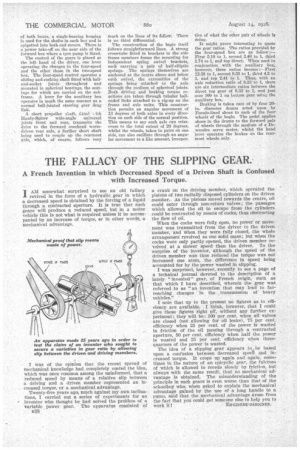THE FALLACY OF THE SLIPPING GEAR.
Page 64

If you've noticed an error in this article please click here to report it so we can fix it.
A French Invention in which Decreased Speed of a Driven Shaft is Confused with Increased Torque.
JAM somewhat surprised to see an old fallacy revived in the form of a hydraulic gear in which a decreased speed is obtained by the forcing of a liquid through a contracted aperture. It is true that such gears will produce a reduced speed; but in a motor vehicle this is not what is required unless it be accompanied by an increase of torque, or in other words, a mechanical advantage.
I was of the opinion that the recent spread of mechanical knowledge had completely ousted the idea, which was once common among the uninformed, that a reduced speed by means of a relative slip between a driving and a driven member represented an increased torque, or a mechanical advantage.
Twenty-five years ago, much against my own inclinations, I carried out a series of experiments for an • inventor who thought he had solved the problem of a variable power gear. The apparatus consisted of u38 a crank on the driving member, which operated the pistons of two radially disposed cylinders on the driven Amember. As the pistons moved towards the centre, oil could enter through non7return valves ; the passages which allowed the oil to escape from the cylinders could be contracted by means of cocks, thus obstructing the flow of oil.
When the cocks were fully open, no power or move-, ment was transmitted from the driver to the driven member, and When they were fully closed, the whole arrangement revolved as one solid mass; but when the cocks were only partly opened, the driven member revolved at a slower, speed than the driver. To the surprise of the inventor, although the speed of the driven member was thus reduced the torque was not increased one atom, the difference in speed being accounted for by the power wasted In slipping.
I was surprised, however, recently to see a page of a technical journal devoted to the description of a lately " invented " gear, of French origin, such as that which I have described, wherein the gear was referred to as `.` an invention that may lead to farreaching. changes in the transmission of heavy vehicles."
I note that up to the present no figures as to efficiency are available. I think, however, that I could give these figures 'right off, without any further experiment; they will be: 100 per cent. when all valves are closed (not allowing for oil leaks), 75 per cent. efficiency when 25 per cent, of the power is wasted in friction of the oil passing through a contracted aperture, 50 per cent. efficiency when half the power is wasted and 25 per cent. efficiency wen threequarters of the power is wasted.
The idea of a slipping gear appears to be based upon a confusion between decreased speea and increased torque. It crops up again and again, sometimes in the nature of an epicyclic gea”, the fulcrum of which is allowed to • recede slowly by friction, but always with the same result, that no mechanical advantage is obtained. The misunderstanding of the principle in such gears is even worse than that of the schoolboy who, when asked to explain the mechanical advantage gained by the use of a long handle to a pump, said that the mechanical advantage arose from the fact that you could get someone else to help you to work it! ENGINEER-DESIGNEE.




















































































































